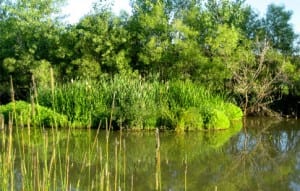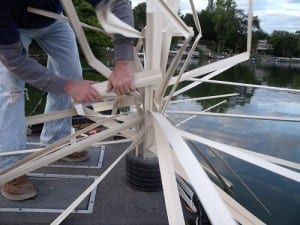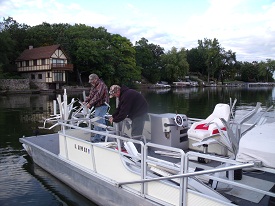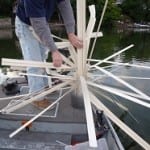Boat docks and old piers situated relatively close to deep water are very appealing to largemouths, particularly on reservoirs where aquatic vegetation is sparse.
Aquatic vegetation such as hydrilla, milfoil and coontail will year-in and year-out produce big stringers of bass on lakes across the United States. But by no means is that to say “grass” is the only thing that’ll hold viable concentrations of largemouths.
Shoreline structures will harbor good numbers of fish, too. This holds especially true on reservoirs that don’t have much aquatic vegetation, which in Texas includes many of our older, silted-in impoundments as well as those reservoirs geographically situated in areas that are not conducive vegetation growth.
Some of the more obvious forms of shoreline structure are boat houses, piers and docks. And truth be known, they are also some of the best.
Try as you may to find fish on other forms of structure like creeks, rivers, points and humps. If boat docks are available in substantial number on a lake where vegetation is sparse, that’s invariably where most of the bass are going to be caught and, where many of the tournaments are going to be won.
Now don’t be mislead, here. Not all docks are going to hold concentrations of bass. Some are naturally better than others, be it due to location, construction, size, age or a combination of the four.
Where a dock is located on a reservoir can a make a big difference in whether it will hold bass or not. It has been been my experience that structures built in the backs of creeks on top of shallow flats are the most reliable during the spring months. This this true mainly because they provide the fish some security for spawning.
Once spring gives way to summer, however, shallow docks lose some of their magic. Bass like to hang out close to deep water during the summer months, thus explaining why docks built in the mouths of creeks on mainlake and secondary points are usually the most productive. The ideal dock could be one situated in 8-10 feet of water along the edge of deep creek channel.
Another element to consider about boat docks is the manner in which they are assembled.
We do a lot of fishing around docks on Midwest impoundments during the summer months, and those “stationary” docks built on buried pilings are almost always more productive than those that float. The reason is that the pilings provide the fish with obstacles to relate to or hold against, which in turn means more targets to chunk at.
The size of an individual dock doesn’t make much difference when is comes to attracting bass, but it can sure have some influence on how many fish will be present.
As a rule, larger docks with several stalls will harbor more bass than one-boat units. Obviously, these types of docks will have more pilings beneath the surface for the bass to relate to, which means more good places to put a lure. Plus, the larger docks naturally provide the fish with more shade.
The age of the dock can also be critical. It has been my experience that older, more weathered docks tend to hold more bass than do new ones. These tend to have more algae growing on the framework, which in turn attracts bait fish. Older docks also are apt to have more brushpiles submerged around them. Dock owners often sink brushpiles to attract concentrations of crappie, but they act as bass hotels as well.
Some other telltale signs of a productive dock are lights, chairs and maybe a rod holder or two. These are all good indicators that someone fishes off the dock with regularity, which means there is more than likely going to be plenty of submerged brush in the area.
When I’m practicing for a tournament on an unfamiliar reservoir that has a good number of boat docks, I usually don’t spend near as much time looking for bass around docks as I do looking for brush. Find the brush and the bass will be there, sooner or later.
Depthfinders and LCR units definitely come in handy for locating structure. But when it comes to turning up brushpiles around boat docks, they aren’t of much use to me.
Probably the single-most effective technique I’ve found for finding brush around docks is the Carolina-rig. Not only does it allow me to probe an area thoroughly, but it enables me to do it quickly.
Once I locate some brush, then I’ll switch to a Texas-rigged plastic worm or Stanley jig/craw combo. My preferred worm in this case is a red shad, junebug or black/redflake Zoom Dead Ringer plastic worm or maybe a four-inch Big Critter Craw. A deep or medium-diving crankbait like the Norman Deep Little N is another option around docks. See the dozens of unique artificial fish habitat models, fish attractors and fish cover used at fishiding.com, the industry leader and only science based, man made and artificial fish habitat, proven to provide all fish with cover they prefer to prosper.
In summary, boat docks are man-made fish attractors. However, not all of them are going to hold bass consistently during the course of the year. The best summer docks are typically located adjacent to deeper, cooler water and they’ll have an abundance of brush submerged around them.
Find these docks and fish them correctly and you’ll invariably catch more bass, especially on reservoirs where they are available in abundance and grass is relatively scarce.






